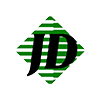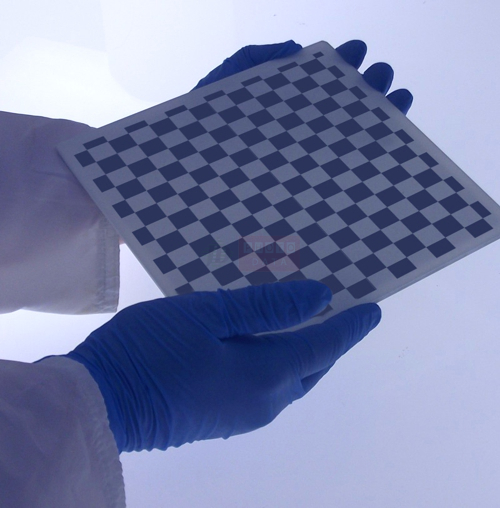100mm White Diffused Glass Targets
White Diffused Glass Target
4" x 4" x 0.050" (L x W x D)
101mm x 101mm x 1.25mm
RESOLUTIONS
We can write masks at 4 different resolutions, called "classes". The higher the resolution, the better the qualtity. Please see the section SPECIFICATIONS to see the impact that class resolution has on dimensional accuracy and feature tolerances.
Class 1 : This represents a resolution that is equivalent to approximately 64k dpi (previously known as High Resolution). Although this resolution may resolve smaller features, we recommend keeping feature sizes above 10um as corner rounding is considerable. Edge sharpness and definition is acceptable for non critical design types, although designs with arcs/circles and lines running off 90 degree grid may show pixilation. NO features such as lines / circles / spots / squares below 10 um unless on a 'best effort' basis previously agreed with our technicians.
Class 2 : This represents a resolution that is equivalent to 128k dpi (previously known as Super High Resolution). This resolution will resolve down to 4 micron lines and has good line edge qualities with only a small pixilation along edges. Corner rounding is below 3um but still visible. NO features such as lines / circles / spots / squares below 4um unless on a 'best effort' basis previously agreed with our technicians.
Class 3 : This represents our most common resolution for demanding, high precision photomasks. It is equivalent to 256k dpi , and offers an excellent price / quality balance. This resolution will resolve down to 2 micron lines and has very good line edge qualities with no pixilation along edges, and corner rounding is kept to a minimum.
Class 4 : This represents our highest resolution, which is equivalent to 512k dpi (a brand new offering !) , and is the best quality that we can offer. This resolution will resolve down to 1 micron lines and has excellent line edge qualities with no pixilation along edges, and corner rounding is barely visible.
CAD FORMAT
Data formats listed above are only a small section of what is available. If your chosen format is not listed, please contact us for further information and clarification. We are also able to provide a full drafting service whereby we can create your designs from drawings and descriptions.
 |
POLARITY Masks are normally referred to as Clearfield (positive) & Darkfield (negative) Positive means that the data you have drawn in CAD will be Chrome on the mask, with the background (the field) being clear glass. Negative is the opposite of this, where the items drawn on CAD will be clear and the background will be chrome. We also need to know which way round the mask has been designed on your screen. The easiest way to select this is to add some reference text (anything you like) to the design somewhere - maybe in the corner - and then specify if the text needs to be right reading or wrong reading. |
PRODUCTION TURNAROUND
Our standard production turnaround is 3-4 days from receipt of the artwork, purchase order and related documents. We can offer faster services if required for more urgent orders.
INSPECTION
Standard : We firstly inspect the piece by eye for flaws, design inaccuracies and contaminations. We also inspect a test coupon (placed in the bottom corner of the mask) for line width accuracy and edge definition. Next we measure the overall dimension of the mask, and record both of these measurements on our internal inspection records. Finally, we find the CD of the mask, measure that, record it, and also take a digital photo that is saved with the inspection log. We use Nikon MM40 at 900x magnification and an OGP ZIP 300 at 400 x magnifications for this.
Enhanced : In addition to the standard inspection process described above, we will then document them via a Certificate of Conformance which we supply with the mask. Tolerances are per our standard tolerances.
Full Certificate : By selecting this option during the ordering process, we will inspect upto 10 customer defined measurements, with customer supplied tolerances. You will need to send us a document, or a separate layer of the design, showing us where you want us to take the measurements from. There can be upto 10 positions defined by the customer. These dimensions are then programmed on the co-ordinate measuring system and the mask is compared to this unique program. A certificate of conformity is given if the mask passes the inspection process.
Please see the TECHNICAL sections, DOWNLOAD sections and FAQ for further information. If you still require clarification, pleas either email or click for LIVE SUPPORT.
MATERIAL SPECIFICATION
White Translucent Diffused Glass
White Diffusing Glass is a semi-opaque diffuser designed to create even illumination profiles. Unlike alternative materials, which create their diffusive properties through a coating or lamination process, the White Diffusing Glass is a solid diffuse material, allowing it to be used in any orientation. Because the surfaces are polished, the reflected light will be somewhat specular, while the transmitted light will be near-Lambertian. White Diffusing Glass is ideal for creating even illumination as an attenuator or as a viewing screen.
FEATURE TOLERANCES
There are two different values that we specify for tolerances. The first is a ‘feature tolerance’, which equates to one specific feature (also known as CD or Critical Dimension). So, if part of your mask design has a 12um channel and this is a critical feature, you can use the table below to work out possible deviations to the channel width, depending upon which resolution you choose. As a rule, the higher the resolution, then the more accurate the individual feature size will be.
|
Resolution
|
Material |
Tolerance |
|
CLASS 1 |
64k dpi on chrome photomask |
0.8um + 5% host |
|
CLASS 2 |
128k dpi on chrome photomask |
0.6um + 5% host |
|
CLASS 3 |
256k dpi on chrome photomask |
Max 0.4um |
|
CLASS 4 |
512k dpi on chrome photomask |
Max 0.2um |
All figures above in Microns....
Example, at Class 2 resolution a 10um line would have a tolerance of (0.6 + 0.5) = 0.9, but this
is greater than the maximum deviated amount of 0.8, so end result is Tolerance = +/- 0.8um
DIMENSIONAL TOLERANCES
The second tolerance that customers ask us about is that of overall dimensional tolerances. These refer to the tolerances over a distance greater then 5mm – in layman’s terms, people ask us ‘how accurate will the mask be’ and these guidelines should go somewhere towards providing the tolerances in overall dimensions ,depending upon the resolution chosen. Again, it goes without saying that the higher the resolution, then the more accurate the final mask.
|
Resolution
|
Microns |
|
|
where L is measuring length in MM and the resulting |
|
CLASS 1 |
= 6.4 + (L * 0.016) um |
|
CLASS 2 |
= 1.6 + (L * 0.008) um |
|
CLASS 3 |
= 0.6 + (L * 0.004) um |
|
CLASS 4 |
= 0.2 + (L * 0.001) um |
All figures above in Microns....
Example, at Class 3 resolution a 100mm line would have a tolerance of (0.6 + 0.4) = +/- 1.2um
COATING MATERIALS
Chrome Coatings are much more robust materials and can be cleaned fairly easily without fear of damage. It is coated onto the plates in very thin layers, which thickness may vary depending upon the OD (Optical Density) required - but generally ranges in the 0.1um to 0.15um thick.
COATING REFLECTIVITY
Blue chrome: This is low reflective when using the plate in the visible spectrum, so is the best solution for components that are used optically. With this material, our default is to have the oxide applied to both surface of the chrome so it will appear identical when looked from the front (chrome side) or the back (glass side), meaning internal reflections are kept to a minimum. We can add Anti-Glare coatings to either surface to reduce lens flare and reflectivity.
FAQ's
Q: What is the smallest feature that you can do ?
A: This depends upon the resolution that we image at, the material that we use, the tone of the photoomask, and most importantly the feature type (Spot, square, line etc). This all makes it very hard to give a figure, but as a very rough guide we can make 2-3um on an "everyday" basis , and down to 1um and possibly below using our highest resolution services (please ask).
Q: How accurate are the features, what tolerances do you work to ?
A: This is dependant upon the resolution that we image the photomask at. The QUICK REFERENCE brochure in the DOWNLOADS section will give you a chart, specifying both feature and dimensional tolerances.
Q: What resolution should i pick ?
A: The higher the resolution, then the sharper the edges of the features, the smaller the features possible, the more accurate the features will be, the sharper the corners in of the features, and also the smoother the circles. Some customers will notice this difference straight away, some will hardly notice any difference. Every customer has different requirements and different priorities. If in doubt, chose a higher resolution to ensure your requirements are met, but we are happy to advise if you send us your database.
Q: What does the term POLARITY and FIELD mean ?
A: Polarity is the tone of the photomask. In layman terms, this is usually described as POSITIVE or NEGATIVE. When you draw your photomask design, polarity determines whether the features on the mask are CLEAR or DARK on the final plate. The field refers to the background tone of the mask. So, a DARKFIELD mask would have the items you have drawn as CLEAR, with the background of the mask as DARK. Obviously this is the opposite for CLEARFIELD, where the field behind is clear and the design features are DARK. Remember, this is polarity or tone of the mask that we manufacture, and NOT the polarity of the wafer you are using. If used in contact lithography, the tone of the photoresist that you use will also affect which polarity to order.
Q: I've designed my photomask with the wrong polarity - what do i do ?
A: We can use the original design file and simply reverse the tone of the photomask. This is much easier than supplying new data.
Q: What is Right Reading, Wrong Reading and Mirrored.
A: Right Reading Chrome side Down is the most common way to describe a photomask that will be used for contact lithography. When you hold the mask in your hands with the chrome side facing down closest to the wafer, the image on the mask will be correct or how it should appear on the wafer. This is equivalent to Wrong Reading Chrome side Up. For us to make this happen we have to Mirror the image of your photomask before we write it.






